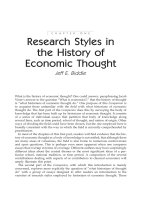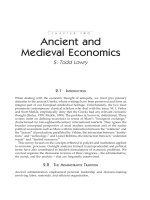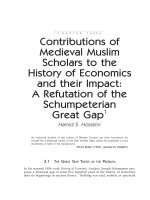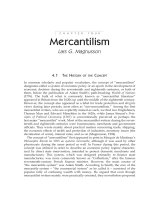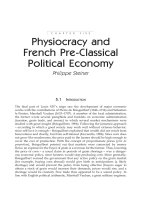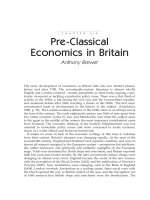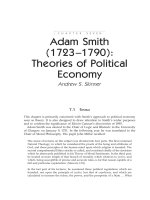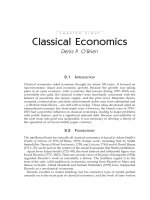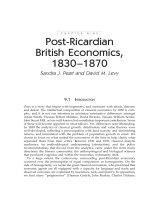A Companion to the History of Economic Thought - Chapter 5 ppsx
Bạn đang xem bản rút gọn của tài liệu. Xem và tải ngay bản đầy đủ của tài liệu tại đây (223.8 KB, 17 trang )
PHYSIOCRACY AND FRENCH PRE-CLASSICAL POLITICAL ECONOMY 61
CHAPTER FIVE
Physiocracy and
French Pre-Classical
Political Economy
Philippe Steiner
5.1 INTRODUCTION
The final part of Louis XIV’s reign saw the development of major economic
works with the contributions of Pierre de Boisguilbert (1646–1714) and Sébastien
le Prestre, Marshall Vauban (1633–1707). A member of the local administration,
the former wrote several pamphlets and booklets on economic administration
(taxation, grain trade, and money) in which several market mechanisms were
studied with great insight (Boisguilbert, 1966). Following the Jansenist approach
– according to which a good society may work well without virtuous behavior,
since self-love is enough – Boisguilbert explained that wealth did not result from
benevolence and charity, but from self-interest (Faccarello, 1986). Since corn does
not grow like mushrooms, the price paid to the farmer should be high enough to
cover the cost of production. With the concept of proportionate prices (prix de
proportion), Boisguilbert pointed out that markets were connected by money
flows: an expense for the buyer of grain is a revenue for the farmer. Thus, lowering
the price of corn – a usual claim in periods of grain shortage – was a danger-
ous economic policy, since farmers would stop producing corn. More generally,
Boisguilbert warned the government that any active policy on the grain market
(for example, buying corn abroad) would give birth to anticipations (a likely
shortage) and would prevent the policy from being effective (buyers eager to
obtain a stock of grain would increase their demands, prices would rise, and a
shortage would be created). Free trade thus appeared to be a sound policy. In
line with English political arithmetic, Marshall Vauban, a great military engineer,
62 P. STEINER
grounded his proposal for a new fiscal system, known as La dîme royale (Vauban,
1992 [1707]), on calculations. He suggested that an increase in the military and
economic power of the king could be achieved together with an increase in the
well-being of the population through an appropriate taxation system: the state
would collect a moderate percentage (from 5 to 10 percent) of the agricultural
produce, whereas commerce and industry would contribute a very small amount
to the royal revenues.
These reflections on economic affairs likely were related, on the one hand, to
the poor situation of the realm (with a series of bad weather conditions in
1693–4, 1698–9, and 1709–10, accompanied by famines and a huge mortality –
up to one-tenth of the population) and, on the other, to continuous warfare with
the continental power (the Austrian Empire) or with the maritime power (The
Netherlands). The situation in the 1750s was again marked by military conflict –
the Seven Years’ War (1756–63) between France and England – but, as recent
French historiography has demonstrated (Perrot, 1992; Théré, 1998), economic
affairs were then a public concern.
First, several journals appeared, such as the Journal Œconomique (1751–72), the
Journal du commerce (1759–62), the Journal de l’agriculture, du commerce et des finances
(1765–74), and the Ephémérides du citoyen (1767–72; second series 1774–6). The first
promoted agronomy and pushed for more rational husbandry; and the second,
in which one may find influences from Cantillon’s work, was devoted to the
science of commerce; whereas the last two were partially or completely domin-
ated by the physiocrats. Secondly, the Intendant du commerce, Jacques Vincent
de Gournay (1712–59), gathered a group of young men, including François Véron
de Forbonnais (1722–1800) and Anne-Robert-Jacques Turgot (1727–81), in order
to promote the study of commerce. Finally, the number of economic publications
exploded after the middle of the century (table 5.1), the authors coming from
all of the enlightened strata of French society: out of 1587 authors during the
period 1750–89, about 10 percent were landowners, farmers, or manufacturers,
10 percent were ecclesiastics, and 6.5 percent were military officers, but the vast
majority came from intellectual strata, with educators and men of letters (14.5
percent), lawyers, judicial officers, or financial magistrates (21 percent), or doctors
and surgeons (6.5 percent).
This very active period in French political economy was dominated by François
Quesnay and Turgot, whose work we will now consider in greater detail.
Table 5.1 Ten-yearly movements in economic publications, 1700–1789
1700–10 1710–20 1720–30 1730–40 1740–50 1750–60 1760–70 1770–80 1780–89
60 54 77 72 85 349 560 627 1284
(%) 2 1.5 2.5 2 2.5 10.5 17 19 39
Source: Based on Théré (1998), table 1.2.
PHYSIOCRACY AND FRENCH PRE-CLASSICAL POLITICAL ECONOMY 63
5.2 QUESNAY AND THE ECONOMIC THEORY OF
AN
AGRICULTURAL KINGDOM
François Quesnay (1694–1774) began his career as a surgeon, and then became
a physician, working for the nobility and finally at the court in Versailles, where
he was the protégé of Mme de Pompadour, the favorite of the king, Louis XV
(Weulersse, 1910). He was well established in his profession, a member of the
Académie des sciences (Paris) and of the Royal Academy of Sciences (London),
and author of several books on medical subjects. Why he left this domain to
become an economic thinker remains unclear.
The first step came with a new, enlarged, edition of his Traité de l’œconomie
animale (Quesnay, 1747), in which he introduced considerations related to the
theory of knowledge and rational behavior. He critically examined major philo-
sophers of the day (Nicolas Malebranche and John Locke) in order to deliver
his own interpretation of Condillac’s sensualism, to which he added the con-
cept of order borrowed from Malebranche’s Cartesianism. This approach was
reassessed in his first contribution to the Encyclopédie (“Evidence,” 1756), in
which Quesnay stressed the difference between self-interest and enlightened
self-interest or rational behavior, the one needed amongst landlords and the
administration in order to reach the state of bliss.
The second and decisive step came when Quesnay wrote five papers (“Fermier,”
“Grains,” “Hommes,” “Impôts,” and “Intérêt de l’argent”) to be published in the
Encyclopédie: due to difficulties with the royal censorship, only the first two
papers were published; nevertheless, all of them circulated and the last one
appeared in the Ephémérides du citoyen in 1765. Quesnay then met the Marquis de
Mirabeau (1715–89), whose fame was high after the publication of L’ami des hommes
(1756–60), and turned the populationist into a fierce advocate of the new science.
They jointly wrote two major books (Théorie de l’impôt in 1760 and Philosophie
rurale in 1763) and a school grew up, with Pierre-Samuel Dupont de Nemours
(1739–1817), l’Abbé Baudeau (1730–92), whose journal (Ephémérides du citoyen)
became the journal of the school, and Pierre-Paul le Mercier de la Rivière (1727–
1801), whose book (L’ordre naturel et essentiel des sociétés politiques, 2001 [1767])
gave a general and methodical exposition of the whole doctrine. At their height,
the physiocrats were sufficiently influential to promote a free trade policy, with
an Act passed in 1764 concerning the freedom of the grain and flour trade.
5.2.1 Economic policy, the price of grain,
and taxation
In the papers written in the years 1756–7, Quesnay was busy with economic
government, defined thus:
The state of the population and of the employment of men is therefore the principal
matter of concern in the economic government of states, for the fertility of the soil,
the market value of the products, and the proper employment of monetary wealth
64 P. STEINER
are the results of the labour and industry of men. These are the four sources of
abundance, which co-operate in bringing about their own mutual expansion.
But they can be maintained only through the proper management of the general
administration of men and products; a situation in which monetary wealth is valueless is
a clear evidence of some unsoundness in government policy, or oppression, and of
a nation’s decline. (Quesnay, 1958, p. 512; Meek, 1964, p. 88; emphasis in the original)
He strongly rejected the economic policy of the French kingdom, a policy too
close to the commercial interest, what Quesnay labeled the merchant’s system
(le système des commerçants, Quesnay, 1958, p. 555), with monopolies, chartered
companies, and the like (ibid., p. 523). Mesmerized by Amsterdam, with its com-
mercial and monetary wealth, French governments since the time of Colbert, the
great minister of Louis XIV, had been misled. Dutch economic government did
not fit the French situation, claimed Quesnay, since The Netherlands was a com-
mercial republic with few lands, whereas France was an agricultural kingdom, a
large country with a rich soil, in need of an economic policy that favored a large
volume of agricultural production that could be sold at a good price (bon prix).
In order to ground his view on economic policy, Quesnay reconsidered some
basic theoretical issues. In “Hommes” and in chapter VII of the Philosophie rurale,
he made a distinction between use value and monetary value, the latter being the
true subject matter of political economy. Wealth is then defined as the goods ex-
changed on the market against money, in conformity to their value (ibid., p. 526);
however, he had no explicit theory of value and price formation. He noted that
use value cannot explain market value, since the latter is continuously changing
whereas the former does not, but he contented himself with stating that prices
were evolving according to a large number of unspecified circumstances (ibid.,
p. 526). He later urged his adversaries to write an “Essay on prices” that would
offer “a fundamental contribution in order to close the discussions in this domain”
(ibid., p. 750). Quesnay overcame the lack of a theory of price by presenting
a large number of specific prices combined in an insightful comparison between
two economic governments, autarky and free trade (Vaggi, 1987; Steiner, 1994,
1998b), the core of which is given in two tables, here presented in a slightly modi-
fied form (table 5.2).
In a manner reminiscent of Cantillon’s definition of the entrepreneur (Cantillon,
1997, pp. 28–33), Quesnay’s farmer has to assume certain costs (the fundamental
price or the production cost plus rent – accordingly, the fundamental price is a
production price, since it contains a part of the net surplus) with uncertain rev-
enues, depending on the climate and the actual economic policy. Given a stable
distribution of the climate over a period of five years, the model focuses on prices
and revenues, the economic policy being considered as the independent variable.
In the absence of free trade, current market prices within the nation differ from
international prices and, except in the case of a bad harvest, the former is below
the latter since the nation is rich and fertile; this situation is detrimental to both
the seller (the farmer, since the merchant is left out) and the buyer (the final
consumer). The consumer is supposed to buy the same quantity of corn (three
units) each year in order to fulfill his basic needs. Accordingly, the current sum
PHYSIOCRACY AND FRENCH PRE-CLASSICAL POLITICAL ECONOMY 65
spent, or the consumer price, is equal to the quantity times the market price (p
t
)
and the average cost of one unit of corn for the consumer, or the average consumer
price, is 1/5 Σp
t
= 17.4 livres, according to Quesnay’s data. The situation is sub-
stantially different for the producer, since his annual revenue depends on prices
and on the quantity produced (q
t
); accordingly, the average revenue that he gets
for one unit of corn, or the average producer price, is Σp
t
q
t
/Σq
t
= 15.48 livres.
The same unit of corn costs more to the consumer than it yields to the producer;
this is due to the price–quantity relationship, which is the core element of the
model. Quesnay’s price–quantity relationship is a King–Davenant relation, with a
weaker price elasticity (Steiner, 1994), which means that prices overreact to a
fall in production. Finally, in the situation of autarky, net product (annual gross
revenue minus fundamental price) is positive but, on the one hand, there is an
inverse relation between net product and quantity produced and, on the other
hand, producers and consumers have a direct opposition of interest: when the
crop is plentiful, the consumer enjoys abundance and low prices, which means a
loss for the producer, whereas the producer gets a large surplus when the crop is
bad – that is, when there is a shortage and a high price.
Under free trade policy, with the broadening of the market, a different price–
quantity relationship is at work together with a higher current price (p′
t
), except
in the case of a bad harvest. Nevertheless, the average consumer price is not
substantially modified (from 17.4 livres to 18 livres) due to the disappearance of
the very high price that was formerly associated with bad harvest. Meanwhile,
the average producer price jumps from 15.48 livres to 17.6 livres, and the net
product is greater, with 50 livres for 5 years instead of 17 livres formerly. Finally,
consumers and producers have the same interest in a plentiful harvest, since the
inverse net product–quantity produced relation has disappeared with the King–
Davenant price–quantity relation.
Without the help of a theory of price, Quesnay produced a fine piece of eco-
nomic analysis showing the benefits associated with free trade. The improvement
Table 5.2 Economic government: autarky and free trade compared
Autarky Free trade
Fundamental Quality Quantity Market Net surplus Market Net surplus
price of the produced by prices, p
t
(in livres) by prices, p’
t
(in livres) by
(in livres) climate unit of land, q
t
(in livres) unit of land (in livres) unit of land
Plentiful 7 10 –4 16 28
Good 6 12 –2 17 28
74 Average 5 15 1 18 6
Poor 4 20 6 19 2
Bad 3 30 16 20 –14
Source: Based on Quesnay (1958), pp. 532–3.
66 P. STEINER
in the situation of the farmer comes from a small increase in the average price of
corn, which means that wages have no reason to rise substantially, permitting
the export sector to remain competitive abroad. Furthermore, if one takes the size
of the net product as the yardstick for evaluating policy, the system of merchants
appears to be disastrous: in order to get a small net product from commerce,
based on a low cost in manufacturing and in maritime commerce (Steiner, 1997)
– that is, with a low price for corn and low wages – the French kingdom deprives
itself of the large agricultural net product associated with a free trade policy.
According to Quesnay, farmers constitute the core of the productive class,
since the level of production depends on the size of their capital once the correct
economic policy is implemented. In “Fermier,” Quesnay explained that when
farmers are poor (do not have capital of their own), they cannot produce with a
good technique (grande culture), which is characterized by a net product to circu-
lating capital ratio equal to 100 percent, and they must content themselves with a
less productive technique (petite culture), with a lower ratio equal to 35 percent.
The productive sector (agriculture) must be given the priority over the sterile
one (manufacture), and thus Quesnay asked for institutional reforms in favor of
this class, because their wealth was the basic fuel for the recovery of the French
nation. In a period during which France was involved in a costly war against
England, this policy would appeal to a kingdom in need of the financial re-
sources necessary to cope with the high costs of maritime and continental wars
(Steiner, 2002). Nonetheless, it raised some important problems related to the
distribution of wealth.
Rent is determined though a bargaining process between the landlord and the
farmer, but Quesnay did not introduce any specific revenue for the farmer. In his
papers, farmers are supposed to pay both the taxes (whether to the state or to the
Church) and the rent out of the net product; a profit could be conceived as the
remaining part of the net product accruing to the farmer. In the following period,
Quesnay went in a different direction with the single-tax doctrine.
This fiscal doctrine was aimed at diminishing the economic and social costs of
fiscal administration, notably for the people living in the countryside, through a
tax directly paid by those who were the effective taxpayers, the landlords.
Quesnay’s single tax doctrine was a bold policy according to which farmers
would pay the whole net product to the landlords, so that the latter could pay
all of the taxes to the king and the Church. Then farmers would no longer fear
the tax administrators and their capital would be free of any threat, as would
be the agricultural net product that was so important for restoring the nation. The
theoretical cost of this solution was important: from an analytic point of view;
this meant that there was no room for a genuine concept of profit, since all of
the surplus was paid as rent to the landlords. In this respect, the only possible
remaining profit was the temporary profit that the farmer would retain as long as
the productivity of his farm was enhanced, but he had yet to bargain anew his
lease with the landlord (Meek, 1964; Eltis, 1975). In Philosophie rurale, Quesnay,
followed by Dupont’s De l’importation et de l’exportation des grains (1910 [1764]),
used this temporary profit argument to explain how farmers would find the
necessary capital for progressively restoring the agricultural sector: as soon as a
PHYSIOCRACY AND FRENCH PRE-CLASSICAL POLITICAL ECONOMY 67
free trade policy was implemented, farmers would receive a larger revenue while
paying rent on the former and less profitable basis; this extra revenue could be
invested, permitting them to use more efficient techniques (Eltis, 1996).
The political cost of this solution was high, since it demanded that landlords,
many of whom were members of the nobility, pay the taxes. Indeed, Quesnay
carefully explained that his tax system was the best solution for them, since,
directly or indirectly, taxes were being paid by them. It is difficult to believe, how-
ever, that they would have welcomed such a proposal, at least without any political
compensation in terms of the rights of citizenship and political representation.
It is true that the physiocrats were looking for such political representation
(Charles and Steiner, 1999), but they were not very successful in this respect.
5.2.2 The Tableau économique: capital and
the circulation process
Quesnay devoted much effort to understanding the functioning of a large agricul-
tural kingdom in which the government has implemented free trade: the Tableau
économique was the result of this effort.
In line with his theory of knowledge, Quesnay considered that genuine eco-
nomic science should be grounded on sensations; or, more precisely, on facts
grasped through a quantitative dimension. In this respect, Quesnay was close to
Petty’s political arithmetic, in which the latter characterized his approach by the
use of weights and numbers instead of superlatives.
Empirical relevance was a methodological prerequisite for accurate economic
calculations, out of which evidence could make its way through the misleading
arguments that vested interests often spread about during economic debates.
As Quesnay put it in the preface of the Philosophie rurale, “Calculations are to the
science of political economy, what bones are to the human body.” Conscious of
the specificity of the social sciences, he added a rhetorical dimension: “It takes
calculations to critique calculations” (Quesnay, in Mirabeau, 1763, pp. xix–xx).
Nevertheless, calculation was limited to arithmetic and geometry; in his book on
mathematics Quesnay (1773, vol. 5, pp. 26–7) explained that calculus was a meta-
physical tool, free of any sensationalistic basis, and useless in political economy.
Empirical accuracy and rhetorical advantage were important aims, but Ques-
nay added a theoretical one to his approach as far as his economic table was
concerned. In the final remark in his first edition, he told the reader that, by
hypothesis, agricultural techniques permitted the net product to circulating
capital ratio to reach 100 percent but, whatever the actual ratio, wrote Quesnay, the
principles at work in the table were correct (Quesnay, 1958, p. 673). As in Ricardian
“strong cases,” the economic table was constructed to explain the functioning
of basic principles. Which ones? Two kinds of economic table can be distingu-
ished (Cartelier, 1984; Herlitz, 1996), even if, as indicated above, one can make
room for a third kind using the disequilibrium approach in Philosophie rurale,
“Premier problème économique” (1766) and “Second problème économique” (1767)
(Eltis, 1996). The first kind is given in the three successive editions of the zig-zag
68 P. STEINER
Table 5.3 Two economic tables: the zig-zag (1758–9) and the formula (1765)
The zig-zag
Productive
expenses
Landlords’
expenses
Sterile
expenses
Revenue
Annual
advances
Annual
advances
600
reproduce
600 300
300
reproduce
300 300
150
reproduce
150 150
75
reproduce
75 75
The arithmetic formula
Productive
class
Landlords Sterile
class
2
21
11
1
1
1
ab
cd
e
2
Total: 5
Total: 2
formulated in the years 1758–9; the second is limited to the “Analyse de la
formule arithmétique du tableau économique.”
In the zig-zag (table 5.3), the major concern was spending. The formalization
shows how the rent paid by farmers to landlords (600 livres) is successively
received and spent by two other classes (the agricultural or productive class and
the artisan or sterile class), giving rise to the same amount of net product (600
livres). The initial expenditure of the landlords is divided into two equal sums
(300 livres), one for the luxury consumption of food and the other for the luxury
consumption of furniture, clothes, and the like. Then, the sterile class spends half
of the money received (150 livres) to buy food and raw materials from the pro-
ductive class; the other 150 livres is used to reconstitute the capital of the sterile
class, eventually with some goods being bought abroad (Meek, 1964). The pro-
ductive class spends 150 livres to get manufactured goods from the sterile class,
whereas the 150 livres that are left are spent within the sector. The two classes go
on spending half of the money received until all of the money is finally spent.
When this spending process is complete, the gross total revenue received by the
productive class (300 livres from the landlords and 300 livres from the sterile
PHYSIOCRACY AND FRENCH PRE-CLASSICAL POLITICAL ECONOMY 69
class) is equal to the circulating capital (or “annual advances” in Quesnay’s
language) of this class; consequently, the reproduction of the capital generates a
net product of an equal amount, as shown in the central column of the table.
In line with Keynesian insights (a multiplier equal to two), Quesnay showed
that the sums spent by the landlords are crucial: the various classes are related
by flows of money and, to use Michal Kalecki’s language, those in possession of
money (landlords) earn what they spend, whereas others spend what they earn.
Nevertheless, as recognized by François Véron de Forbonnais (1767), who
carefully studied this version of the economic table, the table is not correct as far
as the reproduction of capital is concerned. In the table, the gross revenue (600
livres) and the net revenue (300 livres) of both the sterile class and the productive
class are equal, a result clearly at variance with the principle of exclusive pro-
ductivity of the productive class. Aware of this fact, in his commentary on the
table, Quesnay introduced an extra flow (300 livres) from the sterile class to
the productive class in such a way that the latter obtain a net revenue equal to the
initial amount of the net product (600 livres). This is a clear sign that the eco-
nomic table cannot prove the exclusive productivity of one sector alone, but that
this exclusive productivity was only an hypothesis – a weak one, according to
many contemporaries (Galiani, 1984 [1770]).
Hence, the formula can be considered as an attempt to overcome the remain-
ing difficulty in the zig-zag: how the reproduction of capital (circulating and
fixed capital, money capital) results from the monetary flows between the three
classes. At the outset, the productive class has two units of money, and has
advanced ten units of fixed capital and two units of circulating capital; the sterile
class has only one unit of circulating capital; this capital generates a gross pro-
duction of five units of agricultural goods and two units of manufactured goods.
Then the productive class pays the rent or net produce to the landlords, with the
two units of money. The circulation process begins with (a) landlords spending
half of their rent to get luxury food from the farmers (one unit) and (b) luxury
goods from the artisans (one unit); thereafter, artisans buy one unit of agricul-
tural produce for their food (c), while farmers reconstitute their fixed capital with
one unit of manufactured goods (d), since this capital suffers from an annual
depreciation of one-tenth of its value. Finally, (e) artisans spend this unit of
money buying one unit of agricultural produce in order to reconstitute their
circulating capital.
Summing up, the landlords have spent all the money received as rent in order
to consume; the artisans have sold two units of manufactured goods, and have
spent a corresponding amount of money in order to buy food and to reconstitute
their capital; the circulation process has thus allowed these two classes in the end
to get what they had in the beginning. What about the productive class? They
have sold three of the five units of the agricultural goods produced, they have
bought the necessary manufactured goods in order to reconstitute their fixed
capital, while the two remaining units of agricultural goods reconstitute their
circulating capital. Finally, the money capital is reconstituted as well, since they
have two units of money equal to their gross revenue (three units) minus their
expenses (one unit). Every form of capital is thus reproduced, in value and in use
70 P. STEINER
value, by the class that formerly possessed it: the process of circulation has repro-
duced the initial conditions of production.
The effective spending of all of the money received by the various classes is a
crucial hypothesis; however, Quesnay adds a further hypothesis, since landlords
have to spend half of their rent in each sector. If they do not, if they spend more
in manufactured goods than in food, then, according to Quesnay, the reproduc-
tion of agricultural advances cannot be achieved and a process of decline neces-
sarily ensues. Modern analysis does not confirm this point, since if artisans were
to go on spending all their money buying agricultural produce, agricultural
revenue would be left unchanged and the only effect would be a modification of
the proportion of both sectors in the economy (Cartelier, 1984, 1991).
It was a substantial tour de force to set out the circulation process of a whole
nation within three nodes and five lines. It is no surprise that the formula has
since attracted the attention of major theoreticians: Karl Marx, when he built his
reproduction model (Gehrke and Kurz, 1995); Joseph Schumpeter, when he praised
Quesnay for this first attempt to set forth the general equilibrium approach,
which he considered as the economists’ Magna carta; and Wassily Leontief, when
he modeled the American economy with his input–output table.
5.3 TURGOT: TOWARD A THEORY OF A CAPITALIST ECONOMY
After brilliant academic studies, Anne-Robert-Jacques Turgot gave up his anti-
cipated ecclesiastical career and became a member of the high governmental
administration. He was personally acquainted with Gournay, traveling with him
during the years 1756–7; his first notes on trade, wealth, and money, and several
entries (“Etymologie,” “Existence,” “Expansibilité,” “Foires,” and “Fondation”)
for the Encyclopédie date from that period. Appointed intendant in Limousin, one
of the poorest parts of France, a position in which he remained from 1761 to 1774,
he became an emblematic figure of the reformer. Nevertheless, he often stayed
in Paris and was well acquainted with the physiocrats, Dupont in particular,
and other Parisian salons (he met Adam Smith during the latter’s stay in Paris
in 1765) through which he met Condorcet, one of his major intellectual heirs.
During this period, he wrote his major essays in political economy: on taxes
(Observations sur les mémoires de Graslin et de Saint-Péravy, 1767), on the grain
trade (Lettres au Contrôleur général sur le commerce des grains, 1770), on money and
interest (Valeur et monnaie, 1769; Mémoire sur les prêts d’argent, 1770), and his most
comprehensive book, Réflexions sur la formation et la distribution des richesses (1766).
Louis XVI appointed him Contrôleur général and he served from August 1774 to
May 1776: he reestablished the freedom of the internal grain trade, which had
been suppressed by the former Contrôleur général (Abbé Terray), and he worked
for the freedom of the labor market.
A correct assessment of Turgot’s political economy must cope with his relation
to physiocracy. Recent research emphasizes his differences with Quesnay’s polit-
ical economy (Faccarello, 1992; Ravix and Romani, 1997), suggesting that Turgot
was directly in line with classical political economy (Groenewegen, 1969, 1983b;
PHYSIOCRACY AND FRENCH PRE-CLASSICAL POLITICAL ECONOMY 71
Brewer, 1987), notably for his theory of capital. Turgot’s Lettres au Contrôleur
général sur le commerce des grains offers a good opportunity to see his intellectual
relations to Quesnay, while his theories of value and capital highlight Turgot’s
originality. Hastily written in three weeks at the request of the Abbé Terray,
Turgot endorsed Quesnay’s view of free trade.
5.3.1 Markets and competition
Turgot made intensive use of Quesnay’s concepts of producer and consumer
prices, fundamental prices, and net product; and, according to Dupont’s sum-
mary of one lost letter, Turgot used a table similar to Quesnay’s in “Grains” and
“Hommes,” and endorsed those fundamental ideas according to which free trade
offered what could be now labeled a Pareto-improving policy. However, he added
new insights on the functioning of free trade.
Quesnay had explained why price volatility will diminish, but Turgot raised a
new problem: How could one explain that free trade did not raise the average
price of corn in France? Turgot argued that price would rise only due to a change
between supply and demand. Internal demand had no reason to change, he said,
since the consumer would not change the quantity consumed, and since, in the
short run, there was no reason to believe that producers would change the quan-
tity produced. What about foreign consumers? Are they not ready to buy a large
quantity of French corn at a low price, leaving French consumers short of their
basic foodstuff? Turgot discarded the common argument with which traditional
thinkers opposed free trade: foreign consumers would not buy French corn
unless its price fell below the international price to such an extent that the French
price plus the profit of the capital of the merchant would be inferior to foreign
prices. As simple as it may appear, this reasoning is quite original: it contains the
basic principles of the theory of price and profits that were lacking in Quesnay’s
approach. It also reveals that Turgot was in full command of the principle of
spatial arbitrage between two marketplaces. Furthermore, his letters show that
Turgot had benefited from Boisguilbert’s works, notably the concept of propor-
tionate prices, as is clear from his analysis of the relations between the labor
market and the grain market.
Turgot did not content himself with a static approach; he introduced the neces-
sary outcome related to a higher average producer price. With the rise of the
producer price, profits accruing to farmers give them the possibility of increasing
production when it is in their interest. As a consequence, the demand for labor
will rise, while the supply of grain will do the same: What will be the result of
such a situation? With the rise in farmers’ demand for labor, a rise in either the
number of wage earners or a rise in wages, or both, will ensue; in any case, there
will be a rise in the demand for corn, facing the rise in the quantity produced.
Turgot was not able to provide a solution to this dynamic system, but he argued
that the two market prices (the wage rate and the price for corn) would be
proportionate to each other, and would exist in an “advantageous equilibrium”
in which wages would allow laborers to buy corn, and the price of corn would be
high enough for farmers to make a profit on the cultivation of land:
72 P. STEINER
Since society subsists, then as a rule the necessary proportion between the price
of foodstuff and the price of labour must subsist. However, this proportion is not
so strictly determined that it cannot vary and become around the most just and
advantageous equilibrium. (Turgot, 1770; in 1913–23, vol. III, p. 315)
Indeed, though the proportionate-prices theory is not fully worked out, and
there is no demonstration of the existence and stability of equilibrium, Turgot’s
analysis of competition in terms of the relations between two markets was path-
breaking. Competition, wrote Turgot to Dupont (ibid., vol. II, p. 507), was a less
abstract but simpler and more powerful principle than the economic table.
In the longer run, Turgot considers the case in which population growth
becomes a condition of economic growth through a growing supply of labor in
the nation, even though the lag between birth and capacity to work introduces
some stickiness in the labor market. This growth, together with an increasing
quantity of capital, ensures the possibility of economic growth, and is in line
with the philosophy of progress that he had developed as early as his discourse
in the Sorbonne in 1750 (Meek, 1973), and which he fully worked out in his
four-stage theory in Reflections. Nevertheless, this growth is limited by natural
constraints. In comments in two essays on indirect taxes, Turgot made a
fundamental remark concerning the net product–capital ratio. Contrary to what
Quesnay and the physiocrats had said, it is not possible to say that this ratio is
constant:
If the soil were tilled once, the produce would be greater; tilling it a second and
third time would not just double or triple, but quadruple or decuple the produce,
which will thus increase in a much larger proportion than the expenditure, and this
would be the case up to a certain point, at which the produce would be as large as
possible relative to the advances. Past this point, if the advances are still further
increased, the product will still increase, but less so, and continuously less and less
until an addition to the advances would add nothing further to the produce. (Turgot,
1767; in 1913–23, vol. II, p. 645; Groenewegen, 1977, p. 112)
To this very clear statement regarding nonproportional returns, Turgot adds a
further remark, according to which the best economic situation is not the one
determined by the best production ratio (net product on capital), since it is likely
that a further quantity of capital would provide enough net product to be
a valuable investment. However, since Turgot did not introduce the price of
the product, there was, once again, no precise determination of the equilibrium
point.
5.3.2 Value, capital, profit, and interest
In Valeur et monnaie, Turgot coped with an intricate problem in the theory of
value: How can a social evaluation – the current price – be the result of indi-
vidual evaluation? Like several other economists of the period (Graslin, 1911
[1767]; Condillac, 1980 [1776]), Turgot developed a theory of value grounded on
utility. First, with the sensualistic conception of man as a bundle of desires,
PHYSIOCRACY AND FRENCH PRE-CLASSICAL POLITICAL ECONOMY 73
man’s relation to wealth is conceived in terms of needs and utility. Secondly,
Turgot considers a pure exchange model in which two agents have a fixed ini-
tial stocks of two goods, corn and wood: the process begins with the ordering of
the goods by each agent according his perception of scarcity (rareté); that is,
the utility of the goods balanced by the difficulty of obtaining them. Out of this
preference ordering, there appears an estimated value (valeur estimative) with
which each agent relates the utility of the good to him and the disutility of
obtaining one unit of the good; indeed, the estimated value of one unit of corn
(wood) is smaller than the estimated value of wood (corn) for the agent whose
initial endowment is in corn (wood). Exchange appears as a social relation, as a
result of which agents are better off for two reasons: because they can exchange,
which means that they can benefit from the higher productivity related to the
division of labor (Turgot, 1913–23, vol. III, p. 93; Groenewegen, 1977, p. 144), and
because they exchange less for more, in terms of estimated value. Thirdly, the
bargaining process proper takes place: this process, considered as the working
of competition, is capable of revealing the true price of the good; that is, the
exchange ratio between corn and wood. This ratio, or appreciative value (valeur
appréciative), is the social result of two subjective evaluations of the scarcity of
goods. Since Francis Y. Edgeworth’s formalization of this process, we know that
no single solution exists in this pure exchange model; Turgot’s own solution
introduced something like an equity principle, according to which the difference
between each agent’s estimated value of the good bought and the good sold is
equal. Unfortunately, Turgot’s manuscript stops after a programmatic sentence
according to which he would have considered the general case involving more
than two agents and more than two goods.
Capital theory was Turgot’s second major achievement. Turgot considered his
Reflections to be a general overview of the subject, while also claiming to have
examined in detail the formation and the working of capital and the interest rate.
As a matter of fact, while the physiocrats focused on Quesnay’s economic table –
a tool that Turgot never made use of – he left out algebra, only considering the
“metaphysics of the economic table” (Turgot to Dupont; in Turgot, 1913–23,
vol. II, p. 519). Quesnay had done much on capital theory, but Turgot’s contribu-
tion was much more encompassing and accurate, since he considered all the forms
of capital involved in the functioning of a commercial society, and because he had
a clear concept of profit.
After the various agricultural stages, Turgot examines the commercial stage
characterized by market relations; that is, by the value relations between goods
and money (ibid., §XXXI–LXVIII). When members of commercial society receive
more money than they spend for the satisfaction of their needs, and can spare
this extra money, they transform a part of their revenue into capital. With this
clear definition Turgot offers a simple explanation of the formation of capital,
instead of the physiocratic one which is grounded on imperfections in the
competition between farmers and landlords; furthermore, saving is no longer
associated with hoarding; that is, a diminution in the circulation. According
to his stage theory of progress (Fontaine, 1992), Turgot explains how wealthy
people can earn a living out of land or out of money; this means that any amount
74 P. STEINER
of accumulated wealth is equivalent to land whenever the revenue that the owner
obtains at the end of the period is equal (ibid., §LVIII). How is profit explained?
Like any entrepreneur investing capital, the farmer waits for three different
elements, apart from the return of the value of the initial capital:
firstly, a profit equal to the revenue they would be able to acquire with their capital
without any labour; secondly, the wages and the price of their labour, of their risk
and their industry; thirdly, the wherewithal to replace annually the wear and tear of
their property. (ibid., §LXII)
Thus profit is different from wages, since it is a revenue associated with the
possession and the investment of capital, and has nothing to do with the revenue
of labor. As far as rent and profit are concerned, Turgot explains that profit is
a necessary part of the fundamental price, which means that profit does not
belong to the net product; as in the Ricardian approach, rent becomes a residual
category:
the surplus serves the farmer to pay the proprietor for the permission he has given
to use his field for establishing his enterprise. This is the price of the lease, the
revenue of the proprietor, the net product . . . and the profits of every kind due to
him who made the advances cannot be regarded as a revenue, but only as the return
of the expenses of cultivation, considering that if the cultivator did not get them back,
he would be loath to risk his wealth and trouble in cultivating the field of another.
(ibid., §LXII)
Turgot generalizes his approach to any form of investment, from land to money-
lending, and explains that there exists a stable hierarchy of rates of return associated
with the risk and the trouble assumed. These rates are in mutual relation, through
a process of allocation of resources among the different investment opportunities
and the basic mechanism of competition and economic equilibrium:
The different uses of the capitals produce, therefore, very unequal products; but
this inequality does not prevent them from having a reciprocal influence on
each other, nor for establishing a kind of equilibrium amongst themselves. (ibid.,
§LXXXVII)
In his paper on the interest rate, Quesnay had made a distinction between mer-
chants and the rest of the population: while the former could lend at a rate that
was freely determined by market forces, the rate of interest for the latter should
be legally maintained below the rate of rent, in such a way as to make investment
in land more attractive than financial activities. Turgot did not endorse such an
approach: freely determined by the market forces, the rate of interest is inferior to
the rate of profit in manufacture or agriculture because the risk and trouble
assumed are less important; and there is no need for state intervention. A
low interest rate is a clear indication that capital is abundant in a nation, and
that entrepreneurs can expand their businesses since they can easily borrow the
capital they need.
PHYSIOCRACY AND FRENCH PRE-CLASSICAL POLITICAL ECONOMY 75
5.4 CONCLUSION
French political economy was particularly brilliant in the last period of l’ancien
régime; this is especially true if one also considers the works written by the
adversaries of the physiocrats, Ferdinando Galiani (1984 [1770]) and Jacques
Necker (1986 [1775]), who objected to their abstract approach of political economy
and to their way of implementing reform, discarding both political elements such
as power relationships and disturbing anticipations on the market (Faccarello,
1998; Steiner, 1998a, ch. 2). However, the writings of Quesnay and Turgot were
the most important and influential, whether for their contemporaries or for the
generations that followed.
It is not an overstatement to say that Quesnay and Turgot offered the most
innovative pieces of political economy prior to the work of Adam Smith. Many
commentators on the great Scottish political economist have mentioned his debts
to them (Gronewegen, 1969; Skinner, 1995), while others have stressed how much
the two French economists contributed to the formation of classical political
economy (Groenewegen, 1983b; Brewer, 1987; Cartelier, 1991; Faccarello, 1992).
Their impact was obviously strong in France, whether on economic theory or on
political debate. In the former domain, the works of Condorcet are important, at
least for the movement toward social mathematics, in which Arrow’s impossibil-
ity theorem is found in a reasonably well developed form. In a different direc-
tion, one can find many links between Jean-Baptiste Say’s Traité d’économie politique
(1803) and Turgot, through the influence of Pierre Louis Roederer, notably for his
theory of value grounded on utility.
Among the major points debated in the following decades was the physiocratic
theory of taxation: this is not by chance, since taxation links pure analysis and
political reform. Furthermore, in that period of political turmoil, taxation was
a strong political concern, since citizens were supposed to pay taxes. As a con-
sequence, the “new science” of political economy, to use Dupont’s words, was
directly involved in the transformation of political discourse. Physiocracy, Turgot
included, had created a new political vision, grounded on self-interest, and
opposed to Montesquieu’s and Rousseau’s visions grounded on honor or virtue
(Charles and Steiner, 1999). In order to promote this vision of society, they were
so eager to turn all the traditional elements of the social hierarchy upside down
that Alexis de Tocqueville wittily considered them to have been major promoters
of the revolutionary spirit in France.
Bibliography
Primary literature
Boisguilbert, P. de 1966: Pierre de Boisguilbert ou la naissance de l’économie politique. Paris:
INED.
Cantillon, R. 1997: Essai sur la nature du commerce en général. Paris: INED.
Condillac, Etienne Bonnot, abbé de 1980 [1776]: Le commerce et le gouvernement. Genève:
Slatkine. English translation, Cheltenham: Edward Elgar.
76 P. STEINER
Dupont de Nemours, P. S. 1910 [1764]: De l’exportation et de l’importation des grains. Paris:
Geuthner.
Galiani, F. 1984 [1770]: Dialogues sur le commerce. Paris: Fayard.
Graslin, J J. 1911 [1767]: Essai analytique sur la richesse et sur l’impôt. Paris: Geuthner.
Le Mercier de la Rivière, P P. 2001 [1767]: L’ordre naturel et essentiel des sociétés politique.
Paris: Fayard.
Mirabeau, Victor Riquetti, marquis de 1760: Théorie de l’impôt. Paris.
—— 1763: Philosophie rurale. Amsterdam: Libraires associés.
—— 1999 [1758–60]: Traité de la monarchie. Paris: L’Harmattan.
Necker, J. 1986 [1775]: Sur la législation et le commerce des grains. Roubais: Edires.
Quesnay, F. 1747: Essai physique sur l’œconomie animale. Paris, Cavelier.
—— 1773: Recherches philosophiques sur l’évidence des vérités géométriques. Amsterdam and
Paris: Knapper et Delagnette.
—— 1958: François Quesnay et la Physiocratie, vol. 2. Paris: INED.
Turgot, A R J. 1913–1923: Œuvres de Turgot et documents le concernant. Paris: Alcan.
Vauban, Sébastien le Prestre 1992 [1707]: La dîme royale. Paris: Imprimerie Nationale.
Véron de Forbonnais, F. 1767: Principes et observations économiques. Amsterdam: Chez Marc
Michel Rey.
English translations
Groenewegen, P. 1977: The Economics of A. R. J. Turgot. The Hague: Martinus Nijhoff.
—— 1983a: Quesnay “Farmers” and Turgot “Sur la grande et la petite culture.” Sydney: Univer-
sity of Sydney.
Kuczynski, M. and Meek, R. L. 1972: Quesnay’s tableau économique. London: Macmillan, for
the Royal Economic Society and the American Economic Association.
Meek, R. 1964: The Economics of Physiocracy. Essays and Translation. London: George Allen
& Unwin.
—— 1973: Turgot on Progress, Sociology and Economics. Cambridge, UK: Cambridge Univer-
sity Press.
Secondary literature
Barna, T. 1975: Quesnay’s Tableau in modern guise. Economic Journal, 85, 485–96.
Brewer, A. 1987: Turgot: founder of classical economics. Economica, 54(4), 417–28.
Cartelier, J. 1984: Les ambiguités du Tableau économique. Cahier d’économie politique, 9,
39–63.
—— 1991: L’économie politique de Quesnay ou l’Utopie du Royaume agricole. In François
Quesnay, Physiocratie. Paris: Flammarion, 9–64.
Charles, L. and Steiner, P. 1999: Entre Montesquieu et Rousseau. La Physiocratie parmi les
origines de la révolution française. Etudes Jean-Jacques Rousseau, 11, 83–159.
Eltis, W. 1975: Quesnay: a reinterpretation. Oxford Economic Papers, 27(2), 167–200; 27(3),
327–51.
—— 1996: The Grand Tableau of François Quesnay’s economics. European Journal of the
History of Economic Thought, 3(1), 21–43.
Faccarello, G. 1986: Aux origines de la pensée économique libérale: Pierre de Boisguilbert. Paris:
Anthropos.
—— 1992: Turgot et l’économie politique sensualiste. In A. Béraud and G. Faccarello
(eds.), Nouvelle histoire de la pensée économique, vol. 1. Paris: La découverte, 254–88.
—— 1998: Turgot, Galiani and Necker. In G. Faccarello (ed.), Studies in the History of French
Political Economy. From Bodin to Walras. London: Routledge, 120–95.
PHYSIOCRACY AND FRENCH PRE-CLASSICAL POLITICAL ECONOMY 77
Fontaine, P. 1992: Social progress and economic behaviour in Turgot. In S. T. Lowry (ed.),
Perspectives on the History of Economic Thought, vol. 7: Perspectives on the Administrative
Tradition: From Antiquity to the Twentieth Century: Selected Papers from the History of
Economics Conference 1990. Aldershot, UK: Edward Elgar, for the History of Economics
Society, 76–93.
Fox-Genovese, E. 1976: The Origins of Physiocracy. Economic Revolution and Social Order in
Eighteenth Century France. Ithaca, NY: Cornell University Press.
Gehrke, C. and Kurz, H. D. 1995: Karl Marx on physiocracy. European Journal of the History
of Economic Thought, 2(1), 53–90.
Groenewegen, P. 1969: Turgot and Adam Smith. Scottish Journal of Political Economy, 16(3),
271–87.
—— 1983b: Turgot’s place in the history of economics: A bi-centenary estimate. History of
Political Economy, 15(4), 585–616.
Herlitz, L. 1996: From spending to reproduction. European Journal of the History of Economic
Thought, 3(1), 1–20.
Larrère, C. 1992: L’invention de l’économie au 18e siècle. Paris: Presses universitaires de
France.
Perrot, J C. 1992: Une histoire intellectuelle de l’économie politque. Paris: Editions de l’Ecole
des Hautes Etudes en Sciences Sociales.
Ravix, J T. and Romani, P M. 1997: Le “système économique” de Turgot. In Turgot,
Formation et distribution des richesses. Paris: Flammarion, 1–63.
Skinner, A. 1995: Adam Smith and François Quesnay. In B. Delmas, T. Demals, and P.
Steiner (eds.), La diffusion internationale de la Physiocratie: 18e–19e siècles. Grenoble: Presses
universitaires de Grenoble, 33–57.
Steiner, P. 1994: Demand, price and net product in the early writings of Quesnay. European
Journal of the History of Economic Thought, 1(2), 231–51.
—— 1997: Quesnay et le commerce. Revue d’économie politique, 107(5), 695–713.
—— 1998a: Sociologie de la connaissance économique. Essai sur les rationalisations de la pensée
économique (1750–1850). Paris: Presse universitaires de France.
—— 1998b: La “Science nouvelle” de l’économie politique. Paris: Presses universitaires de
France.
—— 2002: Wealth and power: Quesnay’s Political Economy of the agricultural kingdom.
Journal of the History of Economic Thought, 24(1), 91–110.
Théré, C. 1998: Economic publishing and authors, 1566–1789. In G. Faccarello (ed.), Studies
in the History of French Political Economy. From Bodin to Walras. London: Routledge, 1–56.
Vaggi, G. 1987: The Economics of François Quesnay. London: Macmillan.
Weulersse, G. 1910: Le mouvement physiocratique en France. Paris: Alcan.

